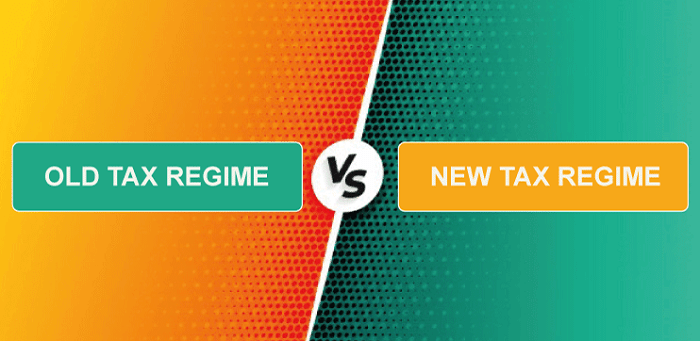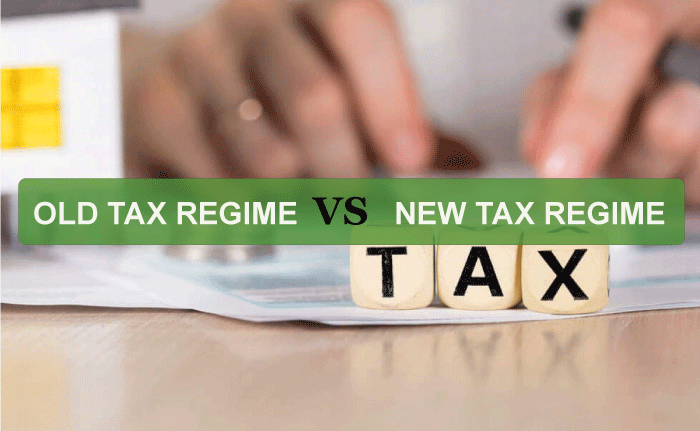Difference Between Old and New Tax Regimes
Introduction
The recently released Budget 2023 has confused many people as most cannot decide which tax regime is better (Old or new). Thus, to promote the acceptance of a new system, the government has included several incentives in the budget for 2023.
Few flexibilities as adjustments are also provided, demonstrating the government's goal to gradually phase out the old system while allowing taxpayers to adapt to the new one. The previous tax system will still be in place even though the new one is now the default.
Old Tax Regime

Following the old taxation system, the assessee could use deductions, exemptions, and other allowances to manage their taxes and reduce their tax burden properly.
The current tax system is convoluted. Although tax rates are high, several ways exist to reduce tax liability. Through the years, the government has added provisions to the Income Tax Act, giving Indian taxpayers access to about 70 exemption and deduction options that enable them to lower their taxable income and therefore pay less tax.
Certain exclusions, including the House Rent Allowance (HRA) and the Leave Travel Allowance, are included in your income (LTA). You can use the deductions to invest, save, or spend money on particular things in order to reduce your tax liability.
The most well-known and considerable deduction is Section 80C, which allows you to deduct up to Rs. 1.5 lakh from your taxable income. Several additional exemptions and deductions are generally accessible to taxpayers.
| Total Income |
Tax Rate |
| ₹0 - ₹ 2,50,000 |
0%₹ |
| ₹ 2,50,000 - ₹ 5,00,000 |
5% |
| ₹ 5,00,000 - ₹ 10,00,000 |
20% |
| Above ₹ 10 lakh |
30% |
Advantages of Selecting the Old Tax Regime
- The old income tax system required investments in particular tax-saving measures, which helped people develop a saving culture over time. It encourages saving for future occasions like marriage, education, property purchases, medical expenses, etc.
Limitations of Selecting the Old Tax Regime
Although the old tax system had numerous advantages, it also had limitations. The following are some limitations of the old tax system:
- The lock-in period for investments limits liquidity in the old tax regime.
- The current level of consumption is a result of committed investment amounts.
- Tax-saving investments aren't readily available in considerable amounts.
- It isn't easy to keep track of the evidence for claimed deductions.
- It is not beneficial for taxpayers with zero or reduced payments eligible for tax deductions
Deductions and Exemptions under Old Tax Regime
| Deductions |
Exemptions |
| Investment in NPS |
Leave Encashment |
| Equity Linked Savings Scheme (ELSS) |
Leave Travel Allowance |
| Employee Provident Fund |
Uniform Allowance |
| Children Tuition Fees |
Standard Deduction |
| Tuition Fee for Children |
Company Leased Car |
| Life Insurance Premium |
Food Coupons or Vouchers |
| Health Insurance Premiums |
Mobile and Internet Reimbursement |
| Public Provident Fund |
House Rent Allowance |
| Principal and Interest Component of Home Loan |
|
| Saving Account Interest |
|
New Tax Regime

Budget 2020 introduced a new tax system with modified tax slabs and favorable tax rates for taxpayers. However, those who choose the new system are not eligible for several exemptions and deductions, including the ones for HRA, LTA, 80C, 80D, and more. As a result, there were few supporters of the new tax system.
The government made a few significant changes in Budget 2023 to convince taxpayers to use the new system. They are:
- Higher Tax Rebate Limit: There is now a full tax rebate on incomes up to Rs. 7 lakhs. Under the previous tax system, this threshold was five lakhs. In other words, taxpayers with incomes up to Rs. 7 lakhs are not required to pay any tax.
- Streamlined Tax Slabs: The new tax slabs are as follows, and the tax exemption level has been raised to 3 lakhs:
| Total Income |
Rate of Tax |
| ₹0-₹3,00,000 |
Nil |
| ₹3,00,000- ₹6,00,000 |
5% |
| ₹6,00,000- ₹9,00,000 |
10% |
| ₹9,00,000- ₹12,00,000 |
15% |
| ₹12,00,000- ₹15,00,000 |
20% |
| Above ₹15,00,000 |
30% |
The tax rates under both regimes compare as below:
| Income Slab |
Old Tax Regime |
New tax Regime (until 31st March 2023) |
New Tax Regime (From 1st April 2023) |
| ₹0 - ₹2,50,000 |
- |
- |
- |
| ₹2,50,000 - ₹3,00,000 |
5% |
5% |
- |
| ₹3,00,000 - ₹5,00,000 |
5% |
5% |
5% |
| ₹5,00,000 - ₹6,00,000 |
20% |
10% |
5% |
| ₹6,00,000 - ₹7,50,000 |
20% |
10% |
10% |
| ₹7,50,000 - ₹9,00,000 |
20% |
15% |
10% |
| ₹9,00,000 - ₹10,00,000 |
20% |
15% |
15% |
| ₹10,00,000 - ₹12,00,000 |
30% |
20% |
15% |
| ₹12,00,000 - ₹12,50,000 |
30% |
20% |
20% |
| ₹12,50,000 - ₹15,00,000 |
30% |
25% |
20% |
| Above ₹15,00,000 |
30% |
30% |
30% |
Family Pension Deduction and Standard Deduction:
- Salary Income: The standard deduction of $50,000, which was earlier only accessible under the old tax system, is now also available under the new tax system. In addition to the rebate, this creates ?7.5 lakhs as one tax-free income under the new tax regime.
- Family Pension: Family pension recipients may deduct either $15,000 or one-third of their pension, whichever is lower.
- Reduced Surcharge for High Net Worth Individuals: Income beyond five crores is now subject to a 25% tax rather than a 37% surcharge. Due to this action, their effective tax rate will drop from 42.74% to 39%.
- Higher Leave Encashment Exemption: The non-government employee exemption limit has increased 8 times, from 3 lakhs to 25 lakhs.
- Default Regime: The new income tax system will be the default starting in FY 2023-2024. You must submit a form to keep utilizing the old system while filing your return. The choice to shift between the two regimes will be available every year.
Advantages of Selecting the New Tax Regime
The following are some advantages of the new tax regime:
- The current tax code is still in effect, and taxpayers can choose the old or new tax code that best suits their needs. The government has not sanctioned any penalties for refusing to switch to the new tax regime.
- The new tax regime gives investors complete freedom over investing their money. Under the new system, your investment pattern is not subject to any obligations, laws, or regulations.
- The taxpayer will be placed in the tax slab that best suits their annual income out of the numerous available.
Limitations of Selecting for the New Tax Regime
The following are the drawbacks of the new tax regime:
- Your net taxable revenue will be higher without any exemptions than it was under the old tax regime.
Exemptions under the New Tax Regime
While the old tax system enjoys several advantages, some types of income remain exempt from taxation under the old and new tax regimes. These are:
- Interest received on a Post Office Savings Account up to 3,500 per Section 10(15)(I).
- Employer's gratuity up to a maximum of Rs. 20 lahks received.
- The amount received upon maturity of a life insurance policy in accordance with Section 10 (10D).
- Employer contributions in NPS or EPF of up to 12% of salary, with interest on EPF of up to 9.5% p.a.
- Income from Life Insurance
- Income from agricultural farming
- Standard reduction on rent
- Retrenchment compensation
- On retirement, leave encashment
- VRS continues up to 5 lakh
- Benefits of retirement and death
- Funding for study earned as a scholarship
- Interest and maturity amount for PPF or Sukanya Samriddhi Yojana
- Commutation of Pension: The new tax law allows you to deduct expenses under Sections 80CCD(2) (employer contributions to recognized pension schemes) and 80JJAA (for new employment).
New Vs. Old Tax Regime Income Tax Slab Rates
| Old Tax Slabs |
Old Income Tax Rates |
New Tax Slabs |
New Income Tax Rates |
| Upto Rs 2.5 lakh |
NIL |
Upto Rs 3 lakh |
NIL |
| Rs 2.5 - Rs 5 lakh |
5% |
Rs 3 lakh - Rs 6 lakh |
5% |
| Rs 5 - Rs 10 lakh |
20% |
Rs 6 lakh - Rs 9 lakh |
10% |
| Above Rs 10 lakh |
30% |
Rs 9 lakh - Rs 12 lakh |
15% |
|
|
Rs 12 lakh - Rs 15 lakh |
20% |
|
|
Above Rs 15 lakh |
30% |
Difference between Old and New Tax Regimes
There is no question that the revised new tax regime proposed in the Budget 2023 is more effective than the present new tax system. When comparing the old and updated tax regimes, however, the comparison is not as straightforward. This is so that even though the old system's tax rates were higher, the amount of tax due was reduced by deductions and exemptions. On the other hand, the new tax system initially planned in Budget 2020 aims to simplify tax calculation by avoiding exemptions and deductions.
Conclusion
There are benefits and drawbacks to both the new and old income tax slabs. The earlier tax system offered many deductions and exemptions, including PPF, ELSS, and Mediclaim, giving the taxpayer many investment options. The new tax system is designed specifically for young investors and people who have just started their careers because their revenue is still developing. So, the only way to establish which tax regime-old or new-is better for you is to enter your income into each to calculate the real tax payable.
|


 For Videos Join Our Youtube Channel: Join Now
For Videos Join Our Youtube Channel: Join Now










